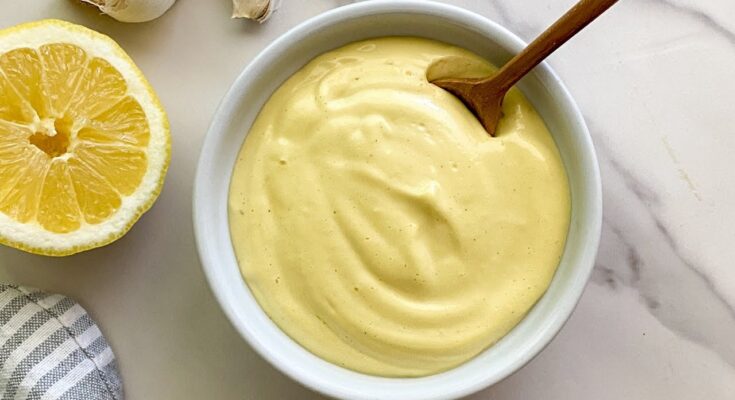Aioli Recipe: Aioli, a luscious and garlicky sauce, is a culinary gem in Mediterranean cuisine. This creamy condiment, often referred to as “garlic mayonnaise,” combines a few simple ingredients to create a versatile addition to many dishes. But what makes it so special? It’s all about the rich flavor and silky texture that elevate even the simplest meals.
Originating from the Mediterranean region, particularly France and Spain, aioli traditionally consists of garlic, olive oil, and salt. Over time, recipes have evolved to include egg yolks and other variations to suit different tastes. Making aioli at home might seem intimidating, but with this detailed step-by-step guide, you’ll master it in no time. Let’s dive in!
Ingredients Needed for Aioli
The beauty of aioli lies in its simplicity. Here’s what you’ll need:
Essential Ingredients:
- 2–3 fresh garlic cloves
- 2 large egg yolks (room temperature)
- 1 cup of high-quality olive oil
- 1–2 teaspoons of lemon juice (freshly squeezed)
- A pinch of salt
Optional Add-ins for Variations:
- A pinch of paprika for a smoky flavor
- Chopped fresh herbs like parsley or dill
- Dijon mustard for added depth
Pro Tip: Always use the freshest ingredients for the best flavor. Fresh garlic and good olive oil are the stars of this recipe!
Equipment Required
You don’t need fancy gadgets to make aioli, but having the right tools can make the process smoother:
Basic Kitchen Tools:
- A sturdy mixing bowl
- A whisk or immersion blender
- A garlic press (optional, but helpful)
- A small measuring spoon
Tips on Choosing the Right Tools:
- Use a glass or metal mixing bowl to stabilize the mixture better.
- An immersion blender can speed up the emulsification process, especially for beginners.
How to Prepare for Making Aioli
Preparation is key to achieving a creamy and well-balanced aioli.
Prepping the Ingredients:
- Peel and finely mince the garlic. For a smoother texture, crush it into a paste using a mortar and pestle.
- Separate the egg yolks from the whites. Ensure the yolks are at room temperature to prevent curdling.
Tips for Best Consistency:
- Drizzle the oil slowly while whisking or blending to avoid breaking the emulsion.
- Keep all ingredients at room temperature for optimal blending.
Step-by-Step Guide to Making Aioli
Step 1: Preparing the Base
In a mixing bowl, combine the egg yolks, minced garlic, and a pinch of salt. Whisk these ingredients together until smooth. This base is crucial as it sets the foundation for the emulsification process.
Step 2: Emulsifying the Mixture
Slowly add the olive oil drop by drop while continuously whisking the mixture. Once the sauce starts to thicken, you can add the oil in a thin, steady stream. If using an immersion blender, pour the oil slowly as the blender runs.
Step 3: Adjusting Flavor and Texture
Once the aioli reaches your desired consistency, mix in the lemon juice. Taste and adjust with more salt or lemon juice as needed. The final product should be creamy, with a balance of tanginess and garlic flavor.
Common Mistakes to Avoid
Even simple recipes can go awry. Here are common pitfalls to sidestep:
- Overmixing: This can cause the aioli to become overly thick or break.
- Temperature Issues: Ensure all ingredients are at room temperature to avoid separation.
- Rushing the Oil: Adding oil too quickly can ruin the emulsification process.
Variations of Aioli
Aioli is incredibly versatile, and you can customize it to match your culinary preferences. Here are some popular variations:
1. Garlic-Heavy Aioli
If you’re a garlic lover, simply double the amount of garlic in the recipe. Crushing the garlic into a paste ensures a strong, even flavor. This version pairs beautifully with roasted vegetables or crusty bread.
2. Lemon and Herb Aioli
For a refreshing twist, add finely chopped herbs like parsley, dill, or chives to the base recipe. Boost the citrus flavor by adding more lemon juice or even some zest. This variation works well with seafood or grilled chicken.
3. Spicy Aioli
Want to add some heat? Mix in a teaspoon of sriracha, cayenne pepper, or a pinch of chili flakes. This spicy version is perfect for burgers, fries, or fish tacos.
Serving Suggestions
Aioli can transform a dish from ordinary to extraordinary. Here are some classic and creative ideas for serving it:
Classic Pairings:
- Serve as a dip for crispy fries or roasted potatoes.
- Use as a spread on sandwiches or wraps for an extra layer of flavor.
- Drizzle over grilled fish or roasted meats as a finishing touch.
Creative Uses:
- Toss with steamed vegetables for a flavorful side dish.
- Mix into pasta salads as a creamy dressing alternative.
- Use as a base for deviled eggs or as a filling for stuffed mushrooms.
Storing Aioli
Homemade aioli doesn’t contain preservatives, so proper storage is essential to maintain its freshness.
Best Practices:
- Transfer the aioli to an airtight container.
- Store it in the refrigerator immediately after preparation.
Shelf Life:
- Aioli typically lasts for up to 4 days in the fridge.
- Discard if you notice a sour smell, discoloration, or separation.
Health Benefits of Aioli
While aioli is indulgent, it does offer some nutritional benefits when consumed in moderation.
Nutritional Value:
- Olive oil provides healthy monounsaturated fats, which are beneficial for heart health.
- Garlic is rich in antioxidants and has anti-inflammatory properties.
Homemade vs. Store-Bought:
- Homemade aioli contains fewer additives and preservatives, making it a healthier choice.
- You also control the ingredients, avoiding excess sodium or low-quality oils often found in store-bought versions.
Aioli for Special Diets
If you follow a specific diet, you can still enjoy aioli by making a few modifications:
Keto-Friendly Aioli: Aioli is naturally keto-friendly because it’s low in carbohydrates and high in healthy fats. Pair it with grilled meats or keto-friendly vegetables like zucchini or cauliflower.
Vegan Aioli Alternative: To make vegan aioli, replace egg yolks with aquafaba (the liquid from a can of chickpeas) or silken tofu. Use plant-based oils like avocado or sunflower oil.
Troubleshooting Aioli Issues
Even seasoned cooks can encounter problems when making aioli. Here’s how to fix common issues:
1. Fixing Broken Aioli: If the mixture separates or becomes too thin, don’t panic. Simply start a new batch with a fresh egg yolk, then slowly whisk the broken mixture into the new base.
2. Avoiding Separation: Ensure the oil is added gradually, and whisk consistently. If you’re using a blender, avoid overprocessing the mixture.
Cultural Importance of Aioli
Aioli isn’t just a condiment; it’s a culinary tradition deeply rooted in Mediterranean culture.
In Mediterranean Cuisine: From Provence in France to Catalonia in Spain, aioli is a staple at family gatherings and festive meals. It’s often served with grilled fish, bouillabaisse, or alongside fresh bread.
Modern Adaptations: Chefs worldwide have embraced aioli, incorporating unique flavors like truffle oil or wasabi to create gourmet versions.
FAQs about Aioli Recipe
What is aioli?
Aioli is a flavorful Mediterranean sauce often used as a condiment or dipping sauce. It’s traditionally made from garlic, olive oil, lemon juice, and egg yolks, which are emulsified to create a creamy, rich texture.
How do I make aioli from scratch?
To make aioli, start by finely mincing garlic and then mixing it with egg yolks. Slowly drizzle in olive oil while whisking vigorously to create an emulsion. Add lemon juice, salt, and pepper to taste. For a thicker consistency, continue to add oil slowly while stirring continuously.
Can I make aioli without eggs?
Yes, you can make an egg-free aioli by using mayonnaise as the base. Mix in minced garlic, lemon juice, and your choice of seasonings to taste. This version is quicker and also suitable for those avoiding raw eggs.
How long can I store homemade aioli?
Homemade aioli can be stored in an airtight container in the refrigerator for up to one week. Ensure it’s covered tightly to maintain its freshness and prevent absorption of other food odors.
What are some common uses of aioli?
Aioli is versatile and can be used as a spread for sandwiches, a dip for vegetables, meats, or seafood, and as a topping for burgers or grilled fish. Its garlic punch enhances the flavor of any dish it accompanies.
Conclusion
Making aioli from scratch is easier than you might think, and the results are undeniably worth it. This creamy, garlicky sauce is versatile, delicious, and adaptable to your preferences. Whether you’re serving it with fries, spreading it on a sandwich, or dressing up a piece of grilled fish, homemade aioli elevates every dish it touches.
Ready to try your hand at this culinary classic? Grab your ingredients, follow this guide, and impress your taste buds with the rich flavors of authentic aioli.



